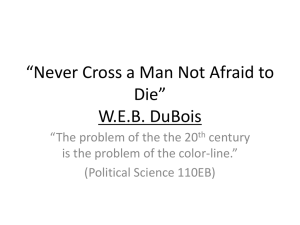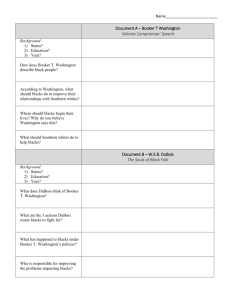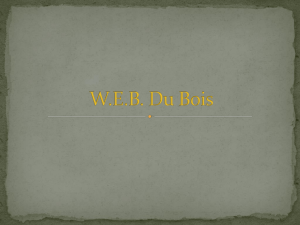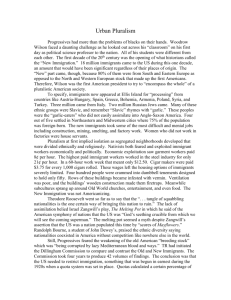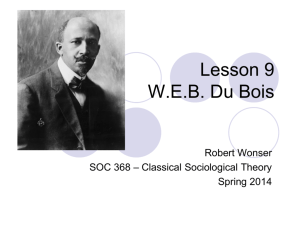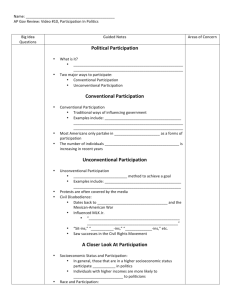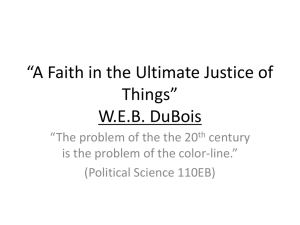07 DuBois
advertisement
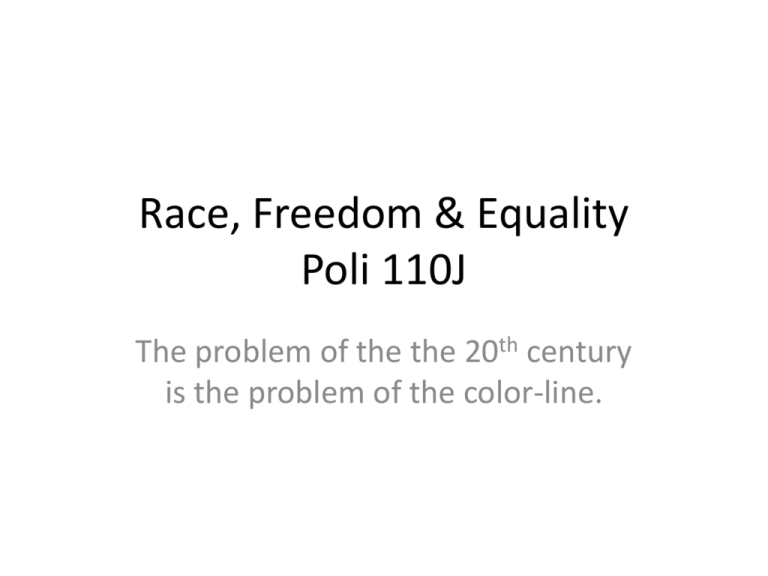
Race, Freedom & Equality Poli 110J The problem of the the 20th century is the problem of the color-line. Essay 2 • 5-7 pages • Due at final exam, Friday Sept. 2nd. – Late essays will not be accepted • If you would like to receive your graded essay at the exam, hand it in no later than Wednesday, Aug. 31st. • Turnitin.com required Essay 2 • 1. “’Howl’ and ‘Footnote to Howl’ perfectly illustrate Marcuse’s arguments, and he would find himself wholly in agreement with Ginsberg.” Agree, disagree, or modify this statement. Essay 2 • 2. Does the Autobiography of Malcolm X support or contradict W.E.B. DuBois’ theories on the importance of education for oppressed minorities? How, and to what extent? Essay 2 • 3. Using Marcuse’s One-Dimensional Man as your source, critique one of the following texts. The text must air or be published between the time that this prompt was assigned and the day that you turn it in: – – – – – Front section of the New York Times or Wall Street Journal A NFL game of your choice Episode of Jersey Shore Episode of Gossip Girl Two hours of a cable news network (CNN, FOX News, MSNBC) W.E.B. Du Bois • • • • • 1868-1963 First black PhD at Harvard Pan-Africanist Radical (equality) Publisher of NAACP’s The Crisis • Communist – MLK: “It is time to cease muting the fact that Dr. Du Bois was a genius and chose to be a Communist.” Du Bois gets radicalized • Sam Hose (1899) – Accused of murdering employer & raping his wife – Admits murder (over debt, possibly in self-defense), denies rape – Lynched w/2,000 witnesses outside of Atlanta – Emasculated, face skinned, tied to a tree and burned alive. Knuckles displayed for sale in shop window. – Lynching a communal activity – Du Bois comes to believe that “one could not be a calm, cool, and detached scientist while Negroes were lynched, murdered, and starved.” Major Themes • • • • • The Veil Double-consciousness Race consciousness Racial essentialism Education Race Consciousness • “How does it feel to be a problem?” – American society consistently and irresistibly forces awareness of one’s own blackness – Blackness is not a quality of appearance, but of identity • Not just what the individual looks like, but who the individual is – Blackness is a “problem” The Problem of the Color Line • The problem of the twentieth century is the problem of the color-line,--the relation of the darker to the lighter races of men in Asia and Africa, in America and the islands of the sea.” – Not geographical, but a “line” nonetheless. – A notably American (and to a lesser extent, European) way of looking at the world. The color line • “Then it dawned upon me with a certain suddenness that I was different from the others; or like, mayhap, in heart and longing, but shut out from their world by a vast veil.” – Parallel worlds – Restrictive only to blacks, who cannot move beyond the veil, while whites can move back and forth. • Privilege. The color line • The American world “yields him no true selfconsciousness, but only lets him see himself through the revelation of the other world. It is a peculiar sensation, this doubleconsciousness, this sense of always looking at one’s self through the eyes of others” The color line • “One ever feels his two-ness,--an American, a Negro; two souls, two thoughts, two unreconciled strivings; two warring ideals in one dark body, whose dogged strength alone keeps it from being torn asunder.” – Internal division on the color line – Partly self, partly not-self – Constant internal conflict The color line • Blacks exist in some sense on both sides of the color line – “He would not Africanize America, for America has too much to teach the world and Africa. He would not bleach his Negro soul in a flood of white Americanism, for he knows that Negro blood has a message for the world.” • Essentialism – Partly inherent, partly historical The color line • “He simply wishes to make it possible for a man to be both a Negro and an American, without being cursed and spit upon by his fellows, without having the doors of Opportunity closed in his face. • “to merge his double self into a better and truer self.” The Color Line • Three parties in Civil War: North, South, Blacks – Freedman’s Bureau constitutes a separate government for liberated slaves • Du Bois on Imperial Japan vs. China • The “blighted, ruined form” of the post-War white “with hate in his eyes” vs. the “form hovering dark and mother-like, her awful face black with the mists of centuries” who had raised his children, buried his wives, and slaked his lust – Metaphor: male & female – “The South believed an educated Negro to be a dangerous Negro” What is to be done From birth till death enslaved; in word, in deed unmanned! .... Hereditary bondsman! Know ye not Who would be free themselves must strike the blow? -Byron (epigraph to III) Booker T. Washington • 1856-1915 • Support from white establishment in North & South • Some support from black leaders – “Leader not of one race but of two” (38) • Advocated assimilation (as does Du Bois), recognition of political & social realities of the South, modus vivendi w/Southern whites – After the War, North & South looked to re-join as a single nation, diminishing patience for the question & fate of blacks in both Sections Booker T. Washington • Washington insists that to advance, blacks must give up hopes for – Political power – Insistence on civil rights – Higher education • In return for – Peace – Industrial schooling • An issue of practicality: believed blacks would benefit most from trade school rather than liberal education – Example: disapproval of poor black boy trying to learn French – Long-term assimilation & advancement Booker T. Washington • In short order, he gets – Black disenfranchisement – Jim Crow laws • Legal inferiority • Example, OK: literacy requirement, unless you were eligible to vote before 1866 – Abandonment of blacks by institutions of higher learning Du Bois’ Criticisms • Washington wants to advance black business, but how can this be done without the right to vote in your own interests? • Insists on thrift & self-respect, but also on “unmanly” submission to whites • Advocates elementary & industrial school, but who will teach at black schools if blacks can’t get higher education? – Imagining a different world 3 bad consequences • 1. South is justified in despising blacks because of blacks’ current degradation – They are in Washington’s depiction ignorant and slothful, not quite up to par with whites & have to catch up 3 bad consequences • 2. Cause of this degradation is the wrong education in the past 3 bad consequences • 3. Idea that the future of blacks in America depends primarily on their own efforts • These are “Dangerous half-truths” for Du Bois – 1. What about slavery and systematic exclusion from politics, economy, society? – 2. black schooling lagged because it had to wait for first generation of black teachers – 3.While blacks must work for their own improvement, Du Bois argues that they must be assisted and encouraged “by the initiative of the richer and wiser environing group” (whites) • Is this problematic? • Du Bois & NAACP insist on more militant, though still peaceful, position, demanding – Right to vote – Civic equality – Education of youth according not to race, but ability • In essence, Du Bois accuses Washington of apologizing and covering over for systematic racism, making it appear as if the disadvantaged position of American blacks has nothing to do with whites and everything to do with blacks. • “By every civilized and peaceful method, we must strive for the rights which the world accords to men, clinging unwaveringly to those great words which the sons of the Fathers would fain forget: ‘We hold these truths to be self-evident…’” Education • Can blacks be educated? • “Most Americans answer all queries regarding the Negro a priori, and that the least that human courtesy can do is listen to evidence.” – Note: not most white Americans – Basic assumptions as part of the Veil Why is education necessary? • This segregation is reinforced the places that blacks & whites live • Either they live in proximity, encountering one another at their worst, or whites own black homes but never encounter their tenants – “…the family of the [former] master has dwindled to two lone women, who live in Macon and feed hungrily off the remnants of an earldom.” Why is education necessary? • Relatedly, uneducated blacks are often victimized in business by outsiders. They can own nothing themselves. – Debt: repossession and exploitation • Deeper and deeper year by year – Whites, Yankees, Jews – Antisemitism Permanent Alienation • Thus, two attitudes come to the forefront: • Disengagement: “Happy?—Well, yes; he laughed and flipped pebbles, and thought the world was as it was. He had worked here twelve years and has nothing but a mortgaged mule. Children? Yes, seven; but they hadn’t been to school this year,--couldn’t afford books and clothes, and couldn’t spare their work.” • Resentment: “Let a white man touch me, and he dies; I don’t boast this,--I don’t say it around loud, or before the children,--but I mean it. I’ve seen them whip my father and my old mother in them cotton-rows till the blood ran” • “Careless ignorance and laziness here, fierce hate & vindictiveness there;--these are the extremes of the Negro problem which we met that day, and we scarce knew which we preferred.” Why is education necessary? • 3 possibilities and dangers at the turn of the 20th Century: • 1. “The multiplying of human wants in culturelands calls for world-wide cooperation of men in satisfying them.” – Globalizing markets serve to bring people into contact and commerce with one another, presenting the possibility for equal exchange Why is education necessary? • “Behind this thought lurks the afterthought of force and dominion,--the making of brown men to delve when the temptation of beads and red calico cloys.” – Color line – Exploitation Why is education necessary? • 2. “The thought of the older South,--the sincere and passionate belief that somewhere between men and cattle, God created a tertium quid, and called it a Negro,--a clownish, simple creature, at times even lovable within its limitations, but straitly foreordained to walk within the Veil.” – A tolerance based in hierarchy Why is education necessary? • Within this, “the afterthought,--some of them with favoring chance might become men, but in sheer self-defence we dare not let them, and we build walls about them so high, and hang between them and the light a veil so thick, that they shall not even think of breaking through.” – Become men = access to the spheres of life reserved for whites – But privileges of whites are based in the exclusion of blacks Why is education necessary? • “The thought of the things themselves, the confused, half-conscious mutter of men who are black and whitened, crying, ‘Liberty, Freedom, Opportunity—Vouchsafe to us, O boastful World, the chance of living men!’” – Assimilationist – Demand/plea for equality – Asking to be treated as humans • To have one’s rights respected is to be acknowledged and be treated as fully human Why is education necessary? • “To be sure, behind the thought lurks the afterthought,--suppose, after all, the World is right and we are less than men? Suppose this mad impulse within is all wrong, some mock mirage from the untrue?” – Double consciousness – Awareness of the hostility of the wider society Who is to be educated? • Men • “The Talented Tenth” • “The rule of inequality:--that of the million black youth, some were fitted to know and some to dig” – Individualistic – Leadership – Serve to raise other blacks “out of the defilement of the places where slavery had wallowed them.” What is the goal of education? • “we almost fear to question if the end of racing is not gold, if the aim of man is not rightly to be rich.” • Some negative social changes result from “the sudden transformation of a fair far-off ideal of Freedom into the hard reality of bread-winning and the consequent deification of Bread.” – Vs. Booker T. Washington’s industrial schooling – Vs. the view of advancement as referring only to money What is the goal of education? • The post-war South has forgotten “the old ideal of the Southern gentleman,--that newworld heir of the grace and courtliness of the patrician, knight, and noble…” in favor of sharp & unscrupulous businessmen. – An odd kind of valorization of the antebellum white Southern elite culture – Non-capitalist What is the goal of education? • Du Bois fears that wealth will become the goal of politics, the fuel of law, and even replace “Truth, Beauty, and Goodness” as the ideal of the Public School. – Why is this a problem? Who doesn’t like money? • Regards “human beings as among the material resources of a land to be trained with an eye single to future dividends.” – Slavery in fact after slavery in law The goal of education • The purpose of education for Du Bois is not to train men (by which he means men) for business, but to train them for life, which is to say confront the whole of the world. – What is the utility of Truth, Beauty, and Goodness for this project? The goal of education • Generates the “breadth and broadening of human reason, by catholicity of taste and culture.” – Character • To overcome the problem of the color line will require “broad-minded, upright men, both white and black, and in its final accomplishment American civilization will triumph.” – Belief in American telos of equality The goal of education • “I sit with Shakespeare and he winces not. … • So, wed with Truth, I dwell above the Veil. Is this the life you grudge us, O knightly America? … Are you so afraid lest peering from this high Pisgah, between Philistine and Amalekite, we sight the Promised Land?” – Transcending power of truth The Role of the Church • “given the peculiar circumstances of the black man’s environment [his religious institutions] were the one expression of his higher life.” – Aesthetic – Spiritual – Philosophical – Economic & social • “Three things characterize the religion of the slave” from which the black church descends – The Preacher – The Music – The Frenzy The Preacher • “A leader, a politician, an orator, a ‘boss’, an intriguer, an idealist.” • Descended from the Medicine Man/Priest – The chief could not survive enslavement, but the Priest could • Christianized by exposure & convenience • Center of the church organization The Music • “The most original and beautiful expression of human life and longing yet born on American soil” • “The articulate message of the slave to the world” • “a faith in the ultimate justice of things” • “Of death the Negro showed little fear, but talked of it familiarly and even fondly” The Music • “They tell us in these eager days that life was joyous to the black slave, careless and happy…” But these songs are “the music of an unhappy people, of the children of disappointment, they tell of death and suffering and unvoiced longing toward a truer world…” The Frenzy • “When the Spirit of the Lord passed by, and, seizing the devotee, made him mad with supernatural joy” • “Old as religion, as Delphi and Endor” • “Many generations firmly believed that without this visible manifestation of the God there could be no true communion with the invisible.” Du Bois on the church • The church is historically the core institution of black society in America – It predates even the monogamic black household – It remains the center of black society and economy – It is also the ethical and political center of black communities Problems • Historically, especially in the South, the church has served not to undermine but to reinforce the oppression of blacks • “Nothing suited [the slave’s] condition better than the doctrines of passive submission embodied in the newly learned Christianity” • Deep religious fatalism – “Children we shall all be free/When the Lord shall appear!” Problems • Transformation of the African into the slave – “Courtesy became humility, moral strength degenerated into submission, and the exquisite native appreciation of the beautiful became an infinite capacity for dumb suffering.” – Losing faith in this world, the slave looked to the next – Marxist criticism of class & religion as applied to race The Enslaving Power of Ideas • Example: “The Coming of John” – John is happy in Altamaha, plays with the Judge’s boy • “One never sees in the North such cordial and and intimate relations between white and black as are everyday occurrences with us [Southerners].” – Goes away to school, sees wider world, advances himself. – Now wants to be addressed not by his first name, but as Mister. The Enslaving Power of Ideas • On return to Altamaha, is denounced by others as “stuck up.” • In church, when he argues that church & sectarian concerns should be replaced in black life with a focus on unity, on racial and social issues, he is “held up to scorn and scathing denunciation for trampling on the true Religion.” The Enslaving Power of Ideas • Thus for Du Bois the structure & beliefs of black society, especially in the South, are complicit in the oppression of black people • As in Marcuse, even though the beliefs and desires are sincere, the are tools of the oppressing group – Consider the Judge: “I like the colored people, and sympathize with all their reasonable aspirations, but you and I both know, John, that in this country the Negro must remain subordinate.” Transcending the Veil • Through Truth – “I sit with Shakespeare and he flinches not” – How does work out for John? • One cannot remain in the world of Truth, the world of Fact must at some point be reckoned with. Transcending the Veil • In Death – John – Burghardt Gomer Du Bois: 1897-1899 • Died of diphtheria in Atlanta, could have been saved. • “He knew no color-line, poor dear, and the Veil, though it shadowed him, had not yet darkened half his sun.” • “Not dead, not dead, but escaped; not bond, but free.” • “Well sped, my boy, before the world had dubbed your ambition insolence, had held your ideals unattainable, and taught you to cringe and bow. Better far this nameless void that stops my life than a sea of sorrow for you.” Transcending the Veil • “Sleep, then, child,--sleep till I sleep and waken to a baby voice and the ceaseless patter of little feet—above the Veil.” • “I shall die in my bonds.” – Behind the Veil, life is a chain – Despite the death of his son, Du Bois asks only that he and hpeople be treated as human beings, having access to the same world as whites. He lives in the hope that blacks and whites will one day be is able to live in equality.
